Cervical Cancer Inequities between Maori and Non-Maori Women in NZ
VerifiedAdded on 2022/10/15
|7
|1774
|331
Essay
AI Summary
This essay delves into the critical issue of cervical cancer inequities in New Zealand, specifically highlighting the disparities between Maori and non-Maori women. It begins with an overview of the rising cancer cases globally and the relatively low mortality and incidence rates in New Zealand, largely due to the National Cervical Screening Program (NCSP). However, the essay emphasizes the significant inequities, where Maori women experience higher incidence and lower survival rates. Factors contributing to this disparity, such as difficulties in accessing services, late-stage disease presentation, cost, cultural insensitivity, and lack of education are discussed. Furthermore, the essay examines the breach of the Waitangi Treaty in relation to these inequities, specifically referencing Articles I, II, and III, and how they relate to healthcare access and equity. The framework provided by the Waitangi Treaty in addressing these inequities is then explored, emphasizing the importance of incorporating Maori voices, community involvement, culturally safe services, and the prioritization of Maori initiatives to bridge the gap. The essay concludes by underscoring the urgent need for genuine commitment and interventions to ensure timely and appropriate access to cervical cancer services for all New Zealanders, particularly Maori women.

Running Head: CERVICAL CANCER INEQUITIES IN NEW ZEALAND 1
Waitangi Treaty breach and inequities in cervical cancer between Maori and non-Maori
women
Name
Institution
Tutor
Date of Submission
Waitangi Treaty breach and inequities in cervical cancer between Maori and non-Maori
women
Name
Institution
Tutor
Date of Submission
Paraphrase This Document
Need a fresh take? Get an instant paraphrase of this document with our AI Paraphraser
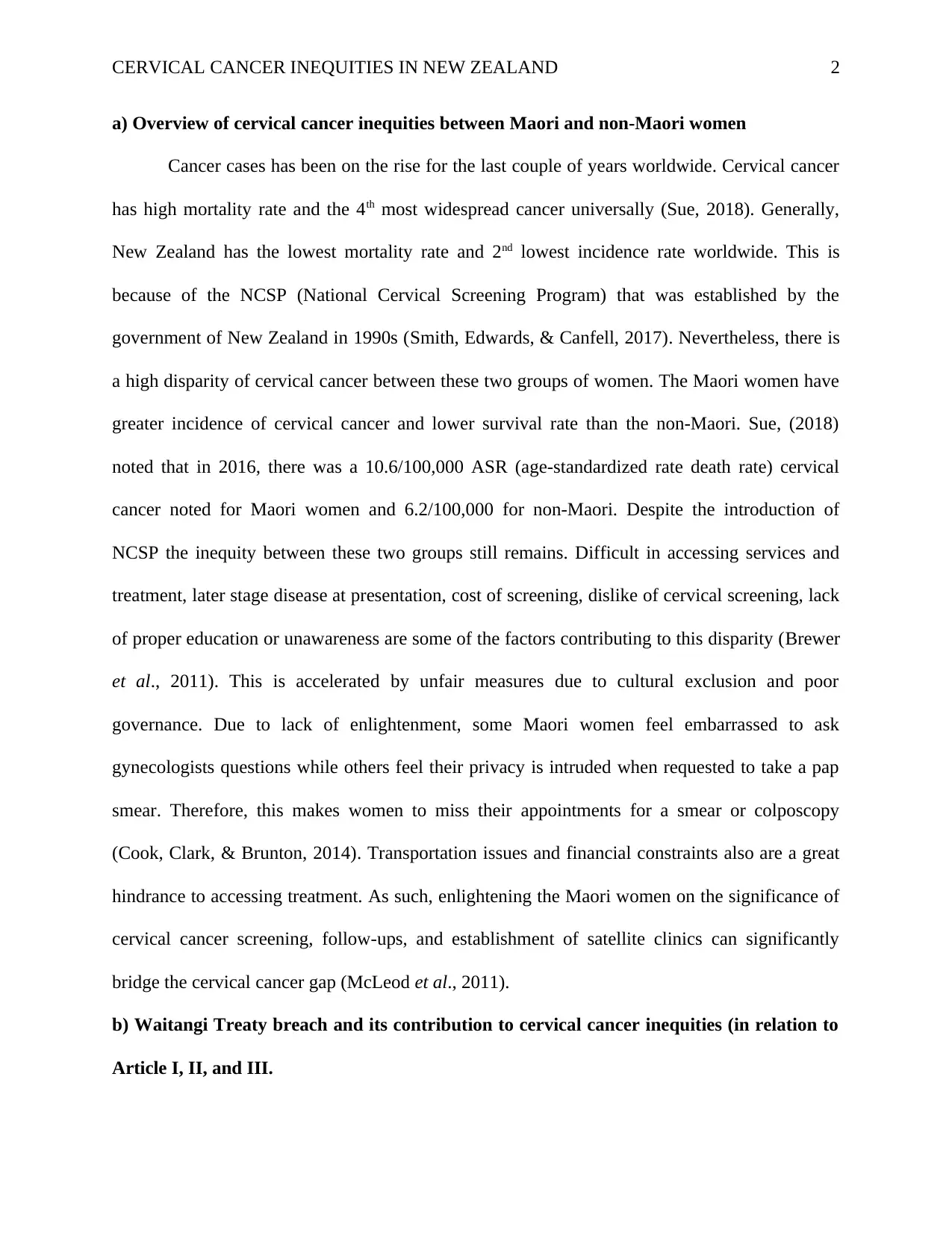
CERVICAL CANCER INEQUITIES IN NEW ZEALAND 2
a) Overview of cervical cancer inequities between Maori and non-Maori women
Cancer cases has been on the rise for the last couple of years worldwide. Cervical cancer
has high mortality rate and the 4th most widespread cancer universally (Sue, 2018). Generally,
New Zealand has the lowest mortality rate and 2nd lowest incidence rate worldwide. This is
because of the NCSP (National Cervical Screening Program) that was established by the
government of New Zealand in 1990s (Smith, Edwards, & Canfell, 2017). Nevertheless, there is
a high disparity of cervical cancer between these two groups of women. The Maori women have
greater incidence of cervical cancer and lower survival rate than the non-Maori. Sue, (2018)
noted that in 2016, there was a 10.6/100,000 ASR (age-standardized rate death rate) cervical
cancer noted for Maori women and 6.2/100,000 for non-Maori. Despite the introduction of
NCSP the inequity between these two groups still remains. Difficult in accessing services and
treatment, later stage disease at presentation, cost of screening, dislike of cervical screening, lack
of proper education or unawareness are some of the factors contributing to this disparity (Brewer
et al., 2011). This is accelerated by unfair measures due to cultural exclusion and poor
governance. Due to lack of enlightenment, some Maori women feel embarrassed to ask
gynecologists questions while others feel their privacy is intruded when requested to take a pap
smear. Therefore, this makes women to miss their appointments for a smear or colposcopy
(Cook, Clark, & Brunton, 2014). Transportation issues and financial constraints also are a great
hindrance to accessing treatment. As such, enlightening the Maori women on the significance of
cervical cancer screening, follow-ups, and establishment of satellite clinics can significantly
bridge the cervical cancer gap (McLeod et al., 2011).
b) Waitangi Treaty breach and its contribution to cervical cancer inequities (in relation to
Article I, II, and III.
a) Overview of cervical cancer inequities between Maori and non-Maori women
Cancer cases has been on the rise for the last couple of years worldwide. Cervical cancer
has high mortality rate and the 4th most widespread cancer universally (Sue, 2018). Generally,
New Zealand has the lowest mortality rate and 2nd lowest incidence rate worldwide. This is
because of the NCSP (National Cervical Screening Program) that was established by the
government of New Zealand in 1990s (Smith, Edwards, & Canfell, 2017). Nevertheless, there is
a high disparity of cervical cancer between these two groups of women. The Maori women have
greater incidence of cervical cancer and lower survival rate than the non-Maori. Sue, (2018)
noted that in 2016, there was a 10.6/100,000 ASR (age-standardized rate death rate) cervical
cancer noted for Maori women and 6.2/100,000 for non-Maori. Despite the introduction of
NCSP the inequity between these two groups still remains. Difficult in accessing services and
treatment, later stage disease at presentation, cost of screening, dislike of cervical screening, lack
of proper education or unawareness are some of the factors contributing to this disparity (Brewer
et al., 2011). This is accelerated by unfair measures due to cultural exclusion and poor
governance. Due to lack of enlightenment, some Maori women feel embarrassed to ask
gynecologists questions while others feel their privacy is intruded when requested to take a pap
smear. Therefore, this makes women to miss their appointments for a smear or colposcopy
(Cook, Clark, & Brunton, 2014). Transportation issues and financial constraints also are a great
hindrance to accessing treatment. As such, enlightening the Maori women on the significance of
cervical cancer screening, follow-ups, and establishment of satellite clinics can significantly
bridge the cervical cancer gap (McLeod et al., 2011).
b) Waitangi Treaty breach and its contribution to cervical cancer inequities (in relation to
Article I, II, and III.
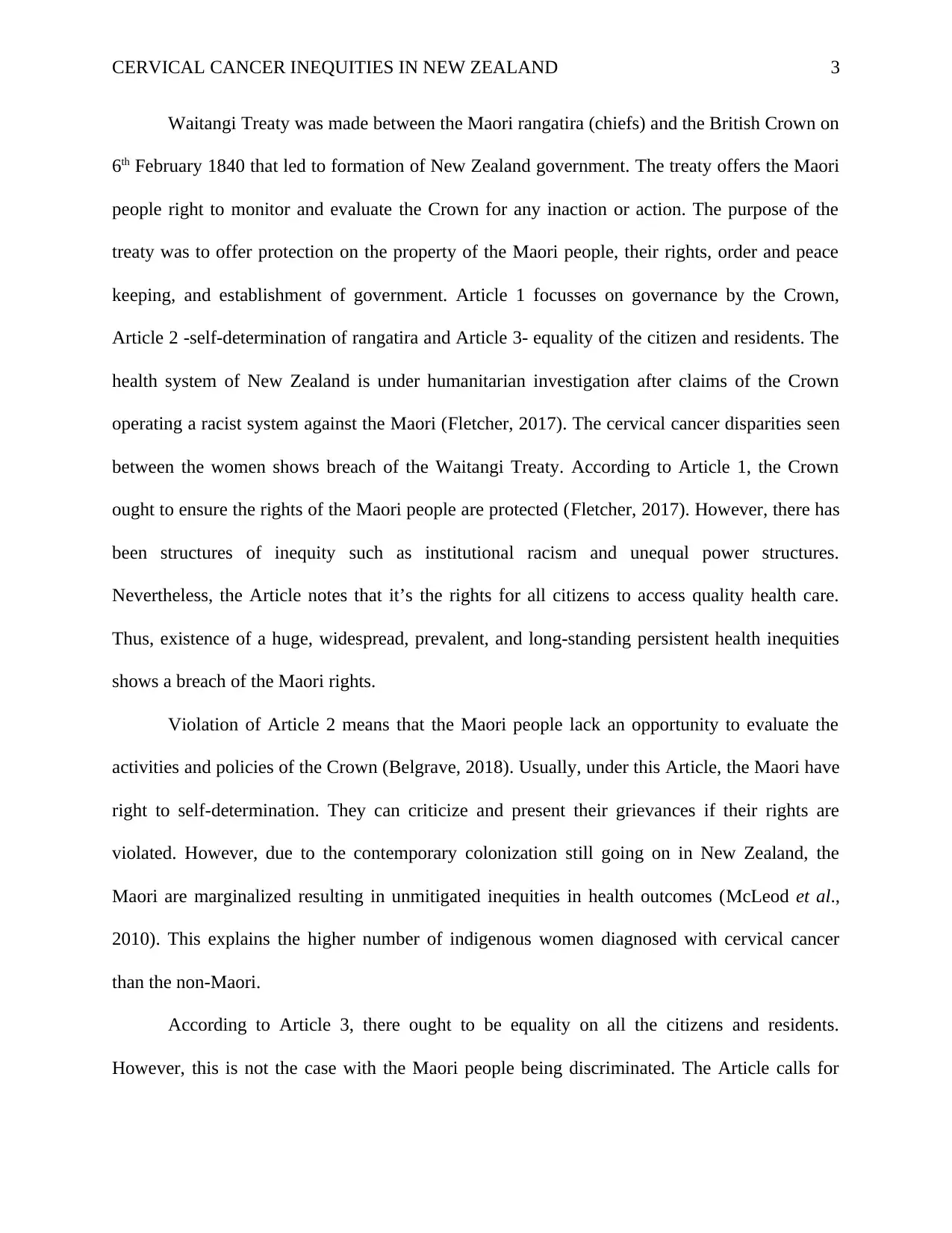
CERVICAL CANCER INEQUITIES IN NEW ZEALAND 3
Waitangi Treaty was made between the Maori rangatira (chiefs) and the British Crown on
6th February 1840 that led to formation of New Zealand government. The treaty offers the Maori
people right to monitor and evaluate the Crown for any inaction or action. The purpose of the
treaty was to offer protection on the property of the Maori people, their rights, order and peace
keeping, and establishment of government. Article 1 focusses on governance by the Crown,
Article 2 -self-determination of rangatira and Article 3- equality of the citizen and residents. The
health system of New Zealand is under humanitarian investigation after claims of the Crown
operating a racist system against the Maori (Fletcher, 2017). The cervical cancer disparities seen
between the women shows breach of the Waitangi Treaty. According to Article 1, the Crown
ought to ensure the rights of the Maori people are protected (Fletcher, 2017). However, there has
been structures of inequity such as institutional racism and unequal power structures.
Nevertheless, the Article notes that it’s the rights for all citizens to access quality health care.
Thus, existence of a huge, widespread, prevalent, and long-standing persistent health inequities
shows a breach of the Maori rights.
Violation of Article 2 means that the Maori people lack an opportunity to evaluate the
activities and policies of the Crown (Belgrave, 2018). Usually, under this Article, the Maori have
right to self-determination. They can criticize and present their grievances if their rights are
violated. However, due to the contemporary colonization still going on in New Zealand, the
Maori are marginalized resulting in unmitigated inequities in health outcomes (McLeod et al.,
2010). This explains the higher number of indigenous women diagnosed with cervical cancer
than the non-Maori.
According to Article 3, there ought to be equality on all the citizens and residents.
However, this is not the case with the Maori people being discriminated. The Article calls for
Waitangi Treaty was made between the Maori rangatira (chiefs) and the British Crown on
6th February 1840 that led to formation of New Zealand government. The treaty offers the Maori
people right to monitor and evaluate the Crown for any inaction or action. The purpose of the
treaty was to offer protection on the property of the Maori people, their rights, order and peace
keeping, and establishment of government. Article 1 focusses on governance by the Crown,
Article 2 -self-determination of rangatira and Article 3- equality of the citizen and residents. The
health system of New Zealand is under humanitarian investigation after claims of the Crown
operating a racist system against the Maori (Fletcher, 2017). The cervical cancer disparities seen
between the women shows breach of the Waitangi Treaty. According to Article 1, the Crown
ought to ensure the rights of the Maori people are protected (Fletcher, 2017). However, there has
been structures of inequity such as institutional racism and unequal power structures.
Nevertheless, the Article notes that it’s the rights for all citizens to access quality health care.
Thus, existence of a huge, widespread, prevalent, and long-standing persistent health inequities
shows a breach of the Maori rights.
Violation of Article 2 means that the Maori people lack an opportunity to evaluate the
activities and policies of the Crown (Belgrave, 2018). Usually, under this Article, the Maori have
right to self-determination. They can criticize and present their grievances if their rights are
violated. However, due to the contemporary colonization still going on in New Zealand, the
Maori are marginalized resulting in unmitigated inequities in health outcomes (McLeod et al.,
2010). This explains the higher number of indigenous women diagnosed with cervical cancer
than the non-Maori.
According to Article 3, there ought to be equality on all the citizens and residents.
However, this is not the case with the Maori people being discriminated. The Article calls for
⊘ This is a preview!⊘
Do you want full access?
Subscribe today to unlock all pages.

Trusted by 1+ million students worldwide
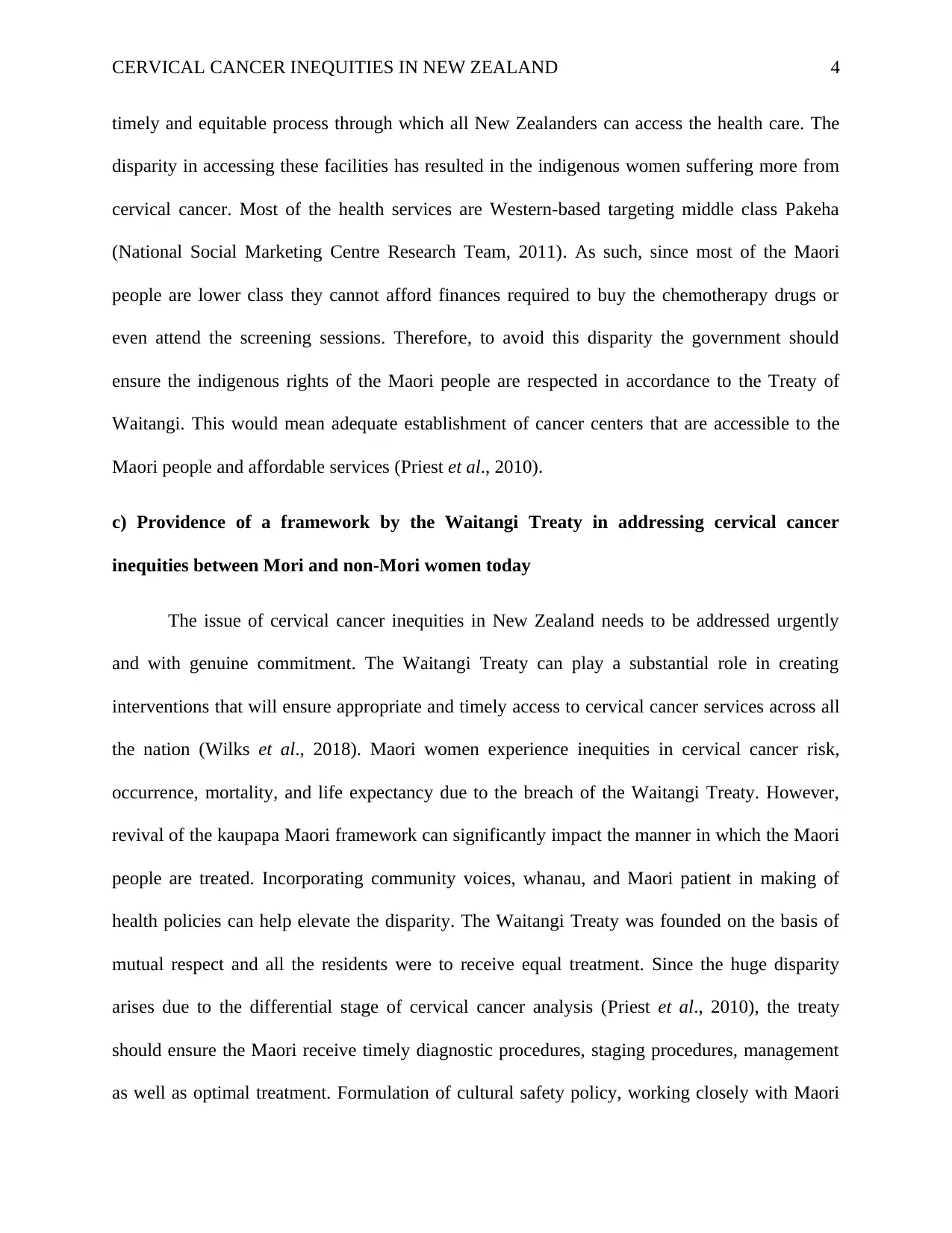
CERVICAL CANCER INEQUITIES IN NEW ZEALAND 4
timely and equitable process through which all New Zealanders can access the health care. The
disparity in accessing these facilities has resulted in the indigenous women suffering more from
cervical cancer. Most of the health services are Western-based targeting middle class Pakeha
(National Social Marketing Centre Research Team, 2011). As such, since most of the Maori
people are lower class they cannot afford finances required to buy the chemotherapy drugs or
even attend the screening sessions. Therefore, to avoid this disparity the government should
ensure the indigenous rights of the Maori people are respected in accordance to the Treaty of
Waitangi. This would mean adequate establishment of cancer centers that are accessible to the
Maori people and affordable services (Priest et al., 2010).
c) Providence of a framework by the Waitangi Treaty in addressing cervical cancer
inequities between Mori and non-Mori women today
The issue of cervical cancer inequities in New Zealand needs to be addressed urgently
and with genuine commitment. The Waitangi Treaty can play a substantial role in creating
interventions that will ensure appropriate and timely access to cervical cancer services across all
the nation (Wilks et al., 2018). Maori women experience inequities in cervical cancer risk,
occurrence, mortality, and life expectancy due to the breach of the Waitangi Treaty. However,
revival of the kaupapa Maori framework can significantly impact the manner in which the Maori
people are treated. Incorporating community voices, whanau, and Maori patient in making of
health policies can help elevate the disparity. The Waitangi Treaty was founded on the basis of
mutual respect and all the residents were to receive equal treatment. Since the huge disparity
arises due to the differential stage of cervical cancer analysis (Priest et al., 2010), the treaty
should ensure the Maori receive timely diagnostic procedures, staging procedures, management
as well as optimal treatment. Formulation of cultural safety policy, working closely with Maori
timely and equitable process through which all New Zealanders can access the health care. The
disparity in accessing these facilities has resulted in the indigenous women suffering more from
cervical cancer. Most of the health services are Western-based targeting middle class Pakeha
(National Social Marketing Centre Research Team, 2011). As such, since most of the Maori
people are lower class they cannot afford finances required to buy the chemotherapy drugs or
even attend the screening sessions. Therefore, to avoid this disparity the government should
ensure the indigenous rights of the Maori people are respected in accordance to the Treaty of
Waitangi. This would mean adequate establishment of cancer centers that are accessible to the
Maori people and affordable services (Priest et al., 2010).
c) Providence of a framework by the Waitangi Treaty in addressing cervical cancer
inequities between Mori and non-Mori women today
The issue of cervical cancer inequities in New Zealand needs to be addressed urgently
and with genuine commitment. The Waitangi Treaty can play a substantial role in creating
interventions that will ensure appropriate and timely access to cervical cancer services across all
the nation (Wilks et al., 2018). Maori women experience inequities in cervical cancer risk,
occurrence, mortality, and life expectancy due to the breach of the Waitangi Treaty. However,
revival of the kaupapa Maori framework can significantly impact the manner in which the Maori
people are treated. Incorporating community voices, whanau, and Maori patient in making of
health policies can help elevate the disparity. The Waitangi Treaty was founded on the basis of
mutual respect and all the residents were to receive equal treatment. Since the huge disparity
arises due to the differential stage of cervical cancer analysis (Priest et al., 2010), the treaty
should ensure the Maori receive timely diagnostic procedures, staging procedures, management
as well as optimal treatment. Formulation of cultural safety policy, working closely with Maori
Paraphrase This Document
Need a fresh take? Get an instant paraphrase of this document with our AI Paraphraser
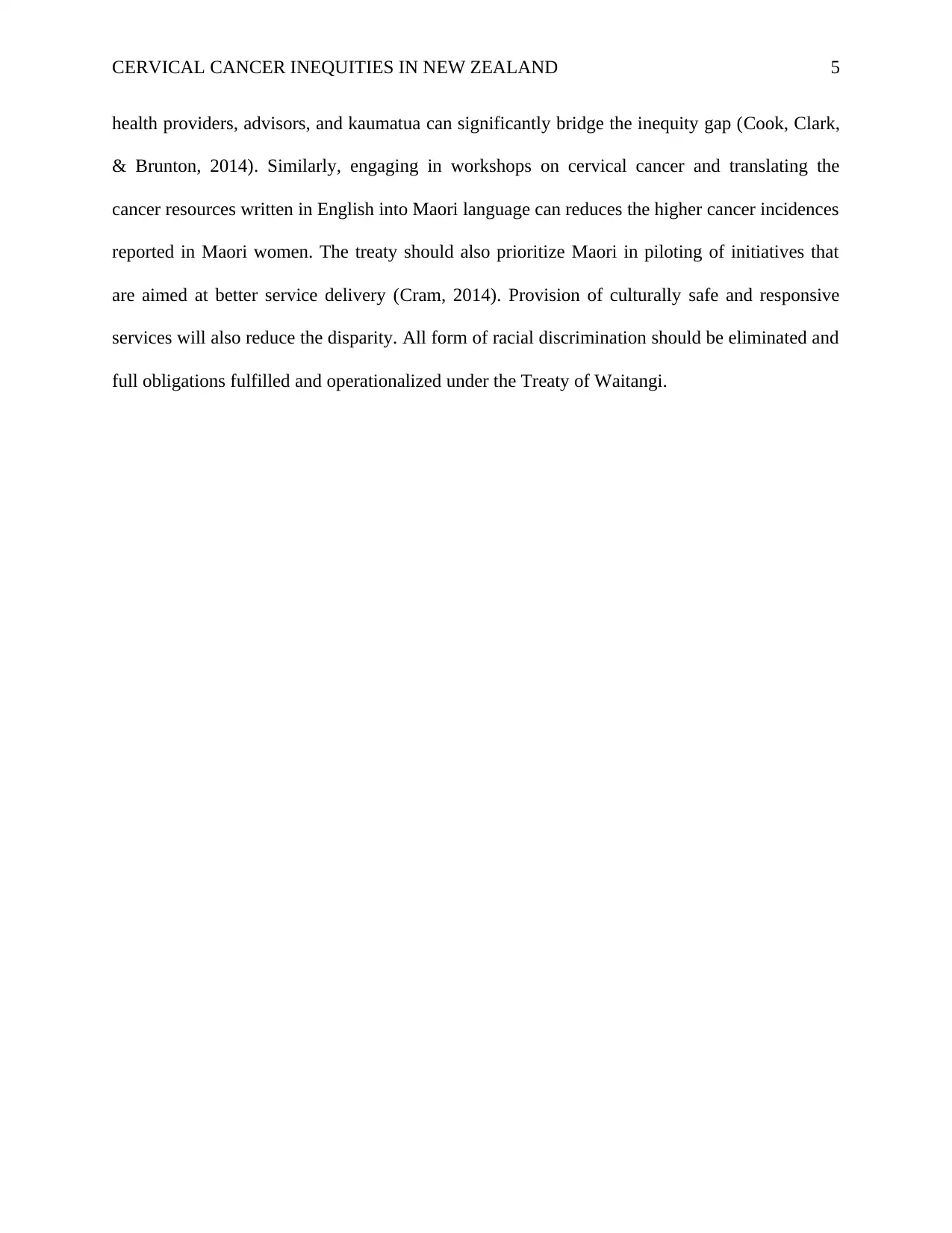
CERVICAL CANCER INEQUITIES IN NEW ZEALAND 5
health providers, advisors, and kaumatua can significantly bridge the inequity gap (Cook, Clark,
& Brunton, 2014). Similarly, engaging in workshops on cervical cancer and translating the
cancer resources written in English into Maori language can reduces the higher cancer incidences
reported in Maori women. The treaty should also prioritize Maori in piloting of initiatives that
are aimed at better service delivery (Cram, 2014). Provision of culturally safe and responsive
services will also reduce the disparity. All form of racial discrimination should be eliminated and
full obligations fulfilled and operationalized under the Treaty of Waitangi.
health providers, advisors, and kaumatua can significantly bridge the inequity gap (Cook, Clark,
& Brunton, 2014). Similarly, engaging in workshops on cervical cancer and translating the
cancer resources written in English into Maori language can reduces the higher cancer incidences
reported in Maori women. The treaty should also prioritize Maori in piloting of initiatives that
are aimed at better service delivery (Cram, 2014). Provision of culturally safe and responsive
services will also reduce the disparity. All form of racial discrimination should be eliminated and
full obligations fulfilled and operationalized under the Treaty of Waitangi.
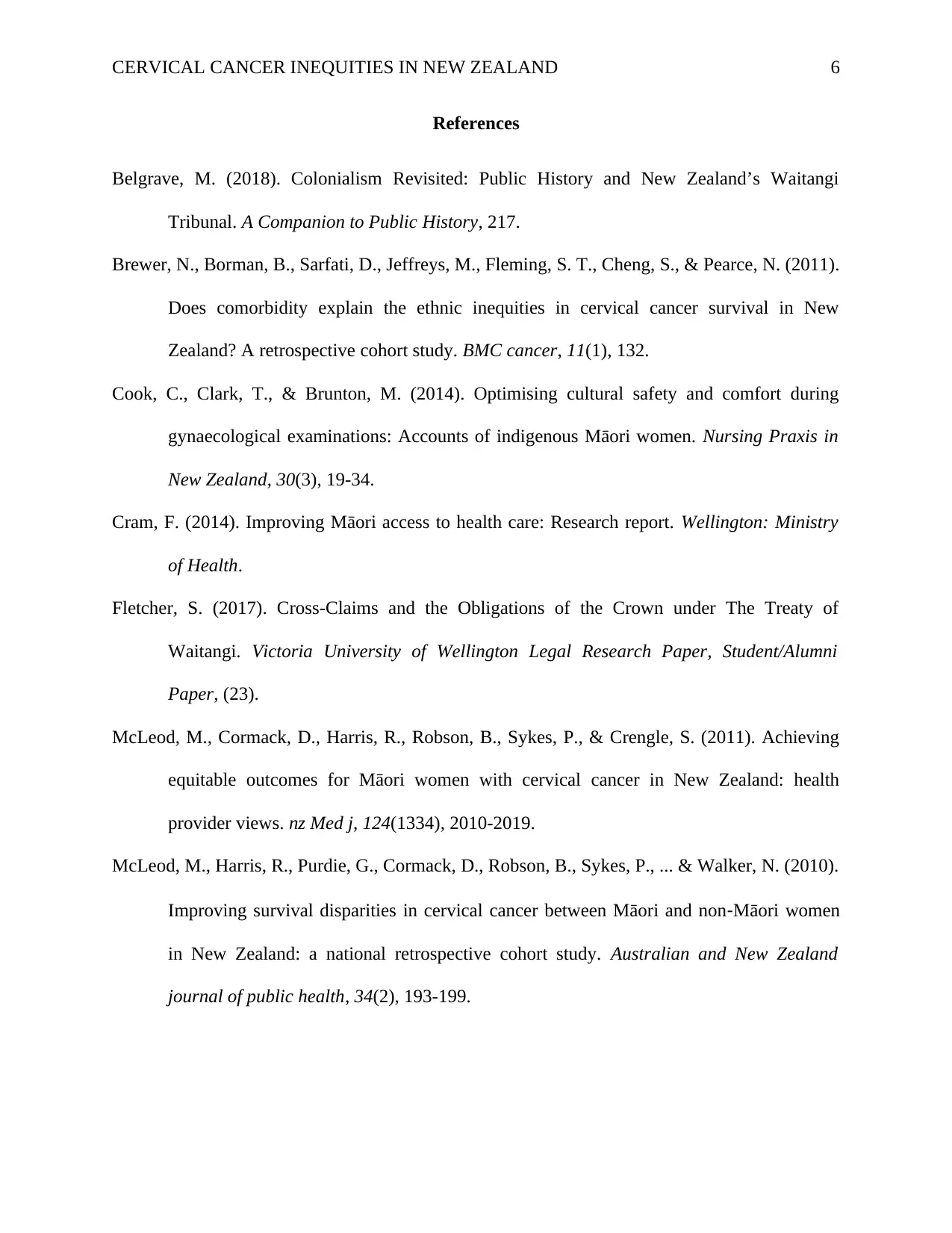
CERVICAL CANCER INEQUITIES IN NEW ZEALAND 6
References
Belgrave, M. (2018). Colonialism Revisited: Public History and New Zealand’s Waitangi
Tribunal. A Companion to Public History, 217.
Brewer, N., Borman, B., Sarfati, D., Jeffreys, M., Fleming, S. T., Cheng, S., & Pearce, N. (2011).
Does comorbidity explain the ethnic inequities in cervical cancer survival in New
Zealand? A retrospective cohort study. BMC cancer, 11(1), 132.
Cook, C., Clark, T., & Brunton, M. (2014). Optimising cultural safety and comfort during
gynaecological examinations: Accounts of indigenous Māori women. Nursing Praxis in
New Zealand, 30(3), 19-34.
Cram, F. (2014). Improving Māori access to health care: Research report. Wellington: Ministry
of Health.
Fletcher, S. (2017). Cross-Claims and the Obligations of the Crown under The Treaty of
Waitangi. Victoria University of Wellington Legal Research Paper, Student/Alumni
Paper, (23).
McLeod, M., Cormack, D., Harris, R., Robson, B., Sykes, P., & Crengle, S. (2011). Achieving
equitable outcomes for Māori women with cervical cancer in New Zealand: health
provider views. nz Med j, 124(1334), 2010-2019.
McLeod, M., Harris, R., Purdie, G., Cormack, D., Robson, B., Sykes, P., ... & Walker, N. (2010).
Improving survival disparities in cervical cancer between Māori and non‐Māori women
in New Zealand: a national retrospective cohort study. Australian and New Zealand
journal of public health, 34(2), 193-199.
References
Belgrave, M. (2018). Colonialism Revisited: Public History and New Zealand’s Waitangi
Tribunal. A Companion to Public History, 217.
Brewer, N., Borman, B., Sarfati, D., Jeffreys, M., Fleming, S. T., Cheng, S., & Pearce, N. (2011).
Does comorbidity explain the ethnic inequities in cervical cancer survival in New
Zealand? A retrospective cohort study. BMC cancer, 11(1), 132.
Cook, C., Clark, T., & Brunton, M. (2014). Optimising cultural safety and comfort during
gynaecological examinations: Accounts of indigenous Māori women. Nursing Praxis in
New Zealand, 30(3), 19-34.
Cram, F. (2014). Improving Māori access to health care: Research report. Wellington: Ministry
of Health.
Fletcher, S. (2017). Cross-Claims and the Obligations of the Crown under The Treaty of
Waitangi. Victoria University of Wellington Legal Research Paper, Student/Alumni
Paper, (23).
McLeod, M., Cormack, D., Harris, R., Robson, B., Sykes, P., & Crengle, S. (2011). Achieving
equitable outcomes for Māori women with cervical cancer in New Zealand: health
provider views. nz Med j, 124(1334), 2010-2019.
McLeod, M., Harris, R., Purdie, G., Cormack, D., Robson, B., Sykes, P., ... & Walker, N. (2010).
Improving survival disparities in cervical cancer between Māori and non‐Māori women
in New Zealand: a national retrospective cohort study. Australian and New Zealand
journal of public health, 34(2), 193-199.
⊘ This is a preview!⊘
Do you want full access?
Subscribe today to unlock all pages.

Trusted by 1+ million students worldwide
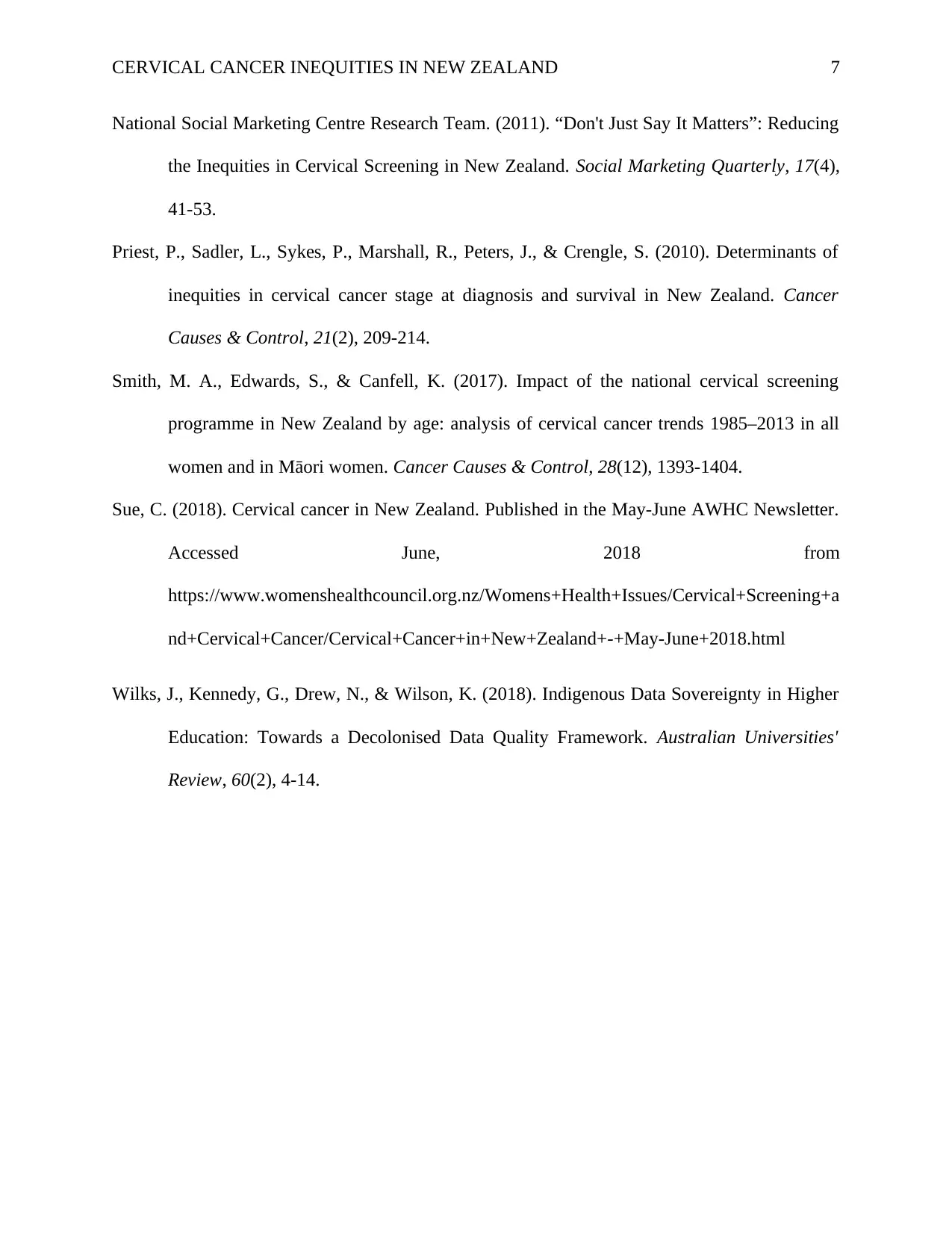
CERVICAL CANCER INEQUITIES IN NEW ZEALAND 7
National Social Marketing Centre Research Team. (2011). “Don't Just Say It Matters”: Reducing
the Inequities in Cervical Screening in New Zealand. Social Marketing Quarterly, 17(4),
41-53.
Priest, P., Sadler, L., Sykes, P., Marshall, R., Peters, J., & Crengle, S. (2010). Determinants of
inequities in cervical cancer stage at diagnosis and survival in New Zealand. Cancer
Causes & Control, 21(2), 209-214.
Smith, M. A., Edwards, S., & Canfell, K. (2017). Impact of the national cervical screening
programme in New Zealand by age: analysis of cervical cancer trends 1985–2013 in all
women and in Māori women. Cancer Causes & Control, 28(12), 1393-1404.
Sue, C. (2018). Cervical cancer in New Zealand. Published in the May-June AWHC Newsletter.
Accessed June, 2018 from
https://www.womenshealthcouncil.org.nz/Womens+Health+Issues/Cervical+Screening+a
nd+Cervical+Cancer/Cervical+Cancer+in+New+Zealand+-+May-June+2018.html
Wilks, J., Kennedy, G., Drew, N., & Wilson, K. (2018). Indigenous Data Sovereignty in Higher
Education: Towards a Decolonised Data Quality Framework. Australian Universities'
Review, 60(2), 4-14.
National Social Marketing Centre Research Team. (2011). “Don't Just Say It Matters”: Reducing
the Inequities in Cervical Screening in New Zealand. Social Marketing Quarterly, 17(4),
41-53.
Priest, P., Sadler, L., Sykes, P., Marshall, R., Peters, J., & Crengle, S. (2010). Determinants of
inequities in cervical cancer stage at diagnosis and survival in New Zealand. Cancer
Causes & Control, 21(2), 209-214.
Smith, M. A., Edwards, S., & Canfell, K. (2017). Impact of the national cervical screening
programme in New Zealand by age: analysis of cervical cancer trends 1985–2013 in all
women and in Māori women. Cancer Causes & Control, 28(12), 1393-1404.
Sue, C. (2018). Cervical cancer in New Zealand. Published in the May-June AWHC Newsletter.
Accessed June, 2018 from
https://www.womenshealthcouncil.org.nz/Womens+Health+Issues/Cervical+Screening+a
nd+Cervical+Cancer/Cervical+Cancer+in+New+Zealand+-+May-June+2018.html
Wilks, J., Kennedy, G., Drew, N., & Wilson, K. (2018). Indigenous Data Sovereignty in Higher
Education: Towards a Decolonised Data Quality Framework. Australian Universities'
Review, 60(2), 4-14.
1 out of 7
Your All-in-One AI-Powered Toolkit for Academic Success.
+13062052269
info@desklib.com
Available 24*7 on WhatsApp / Email
![[object Object]](/_next/static/media/star-bottom.7253800d.svg)
Unlock your academic potential
Copyright © 2020–2025 A2Z Services. All Rights Reserved. Developed and managed by ZUCOL.


